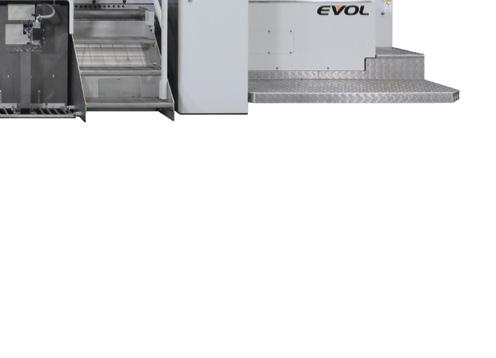
5 minute read
Maximizing Your CRM for Success
BY TODD M. ZIELINSKI AND LISA BENSON
As inflation and interest rates soar, savings dry up, and consumer spending shifts to essentials, boxmakers face uncertainty about sales in the coming months. This comes on the heels of the 2022 fourth quarter, which experienced the largest decline in box shipments since the great recession in 2009. Although the current picture may not seem optimistic, it provides an opportunity to gain market share for companies with a strategy.
Advertisement
A successful downturn strategy will include the mandatory use of a customer relationship management (CRM) system. Having a centralized depository with up-to-date customer information can provide a trove of valuable data to assist in sales and marketing activities. Effectively used CRM systems allow you to identify sales opportunities, track sales activity, and analyze customer buying behavior, all of which can lead to increased sales and revenue. In addition, by analyzing customer data, businesses can create targeted marketing campaigns that are more likely to resonate with their customers, leading to increased marketing effectiveness.
But for a CRM to be effective, it must be used consistently, which means getting buy-in across all levels of the organization. Additionally, thought must be put into how it is set up so impediments to its use are reduced, and its fullest potential is reached. Using a CRM with a mobile app and email integration and automation will make it easier to use and promote consistent use.
At any given time, anyone using your CRM should know whether a contact is a prospect or a customer. Your current client list should be accessible, and it should be clear where opportunities are in the pipeline. They should be able to view records and create reports based on segmentations (e.g., product, territory, industry), sales data (e.g., order history, revenue, projections), and a salesperson’s performance.
If you are setting up a new CRM or are not getting the most out of your current CRM, below are several recommendations to help you maximize its use and performance.
Understand Your Goals
Before your CRM is set up, it is important to understand how you want to use it and what you expect to get from it. Consider all departments using it, such as sales, marketing, customer service, operations, and finance. Each department may have its own needs and goals.
Creating a CRM strategy will allow you to tailor your CRM to meet the goals of all who can benefit from its data. A crucial step is to figure out where you have gaps—data you need but currently do not have easy access to.







Goals should be specific and measurable. With goals in mind, you can begin to set up the fields and properties within the CRM.
Define Data and Pipeline Requirements
Setting up a CRM can be overwhelming, but getting it right is critical to success. It is recommended that you have a CRM administrator who can maintain and manage data and users, as well as ensure best practices are adhered to.
Defi ne the data points and fields that are required. Data should include identifying and quantifiable information. Identifiable data might consist of company information (e.g., name, location, industry, prospect, customer) and contact information (e.g., name, title, phone, email). Quantitative data might include the value of opportunities and sales and engagement with emails and your website if your CRM is tied into your marketing automation.
Create pipelines based on the stages of your sales process and buyers’ journeys. Pipelines allow you to defi ne benchmarks and activities that will be used to move opportunities to the next stage. Th is allows you to see where each opportunity is and what needs to be done to move it along in the pipeline.
Setting up automation and integrations increases efficiency. For example, when integrated with Microsoft Outlook, email exchanges with a prospect or customer can be captured without manually entering them. Integration with marketing automation allows marketers to segment and create email campaigns that can drive engagement and sales. Also, using a rotting or last-touch feature prevents opportunities from being lost because the CRM will notify you of deals that have been idle for too long.
Maintain Clean, Accurate Data
Data integrity is crucial to a successful CRM system. If you are doing a data dump when it is set up, scrub data to ensure it is clean. Gather and store data in a standardized format whenever possible. Use drop-down select or multiselect properties whenever possible, unless you’re collecting unique values (e.g., contact name, company name, messages). Doing so eliminates human error and makes segmenting and fi ltering data for marketing or analysis easier. It also improves the user experience.
Segmentation And Filters
The contacts in your CRM are in various stages and have different needs. Segmentation allows you to build useful lists of customers grouped by data points such as products, location, relationship type, account owner, and revenue. An exclusion fi lter is helpful for marketing activities so that emails are being sent to only those that should get them. With these lists, you can conduct more targeted marketing and sales efforts, and automate activities on those contacts.
Use Automation
Automation relieves your sales and marketing teams of repetitive tasks and boosts productivity. It can support your sales and marketing teams throughout the sales cycle by sending out internal emails, assigning tasks, creating workflows, or sending trigger automated emails based on an action or inaction. Automation allows you to keep activities moving and ensures data remains current.
Leverage Reporting And Analytics
Th ere is power in CRM data when it is used. While your CRM subscription level will govern the depth of reporting available, all of the above eff orts and anything else you do in your CRM can’t be truly maximized, unless you can understand the data and make decisions based on it. Building dashboards can help you understand the eff ectiveness of marketing campaigns and sales eff orts. You can set up shared views and reports in advance that can quickly answer regularly asked questions about marketing, sales, and forecasting data. Evaluating the data will allow you to recognize if you are meeting the goals you created, uncover additional sales opportunities, spot issues in your processes, and make appropriate changes.
Continue To Monitor Your Crm
Keeping data clean and ensuring the CRM is being used will require ongoing eff orts. Th is is why having a designated CRM administrator is essential, and the expectations for all users should be clear from the start. Establish a regularly executed process for cleanup, which can include removing hard-bounced emails and identifying gaps or missing data. Determine why data is missing (the salesperson didn’t input it from a form, etc.), and have the appropriate person populate the data or make corrections in forms or processes to prevent future occurrences.
Get the Most Out of Your CRM
Effectively and consistently using a CRM opens the door to countless more opportunities hidden in your data. All you need to do is take the fi rst step, and start using the tools and features to their fullest potential.
Todd M. Zielinski is managing director and CEO at Athena SWC LLC. He can be reached at 716-250-5547 or tzielinski@athenaswc.com
Lisa Benson is senior marketing content consultant at Athena SWC LLC. She can be reached at lbenson@athenaswc.com
























